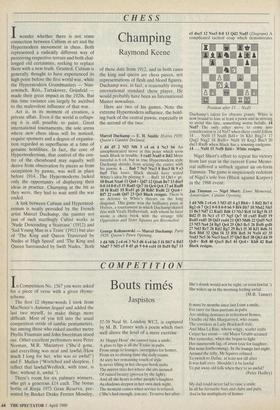CHESS
Champing
Raymond Keene
Iwonder whether there is not some connection between Cubism in art and the Hypermodern movement in chess. Both represented a radically different way of perceiving respective terrain and both chal- lenged old certainties, seeking to replace them with a new truth. Granted, Cubism is generally thought to have experienced its high point before the first world war, while the Hypermodern Grandmasters — Nim- zowitsch, Reti, Tartakover, Griinfeld made their great impact in the 1920s. But this time variance can largely be ascribed to the malevolent influence of that war.
Art is, in its moment of creation, a private affair. Even if the world is collaps- ing it is still possible to paint. Great international tournaments, the sole arena where new chess ideas will be noticed, require sponsors and a degree of organisa- tion regarded as superfluous at a time of genuine hostilities. In fact, the core of Hypermodernism, that control of the cen- tre of the chessboard may equally well derive from observation by pieces as from occupation by pawns, was well in place before 1914. The Hypermoderns lacked only the opportunity of displaying their ideas in practice. Champing at the bit as they were, they had to wait until the war ended.
A link between Cubism and Hypermod- ernism is neatly provided by the French artist Marcel Duchamp, the painter not just of such startlingly Cubist works as 'Nude Descending a Staircase' (1912) and 'Sad Young Man in a Train' (1911) but also of 'The King and Queen Traversed by Nudes at High Speed' and 'The King and Queen Surrounded by Swift Nudes.' Both of these date from 1912, and in both cases the king and queen are chess pieces, not representations of flesh and blood figures. Duchamp was, in fact, a reasonably strong international standard chess player. He would probably have been an International Master nowadays.
Here are two of his games. Note the extreme Hypermodern influence, the hold- ing back of the central pawns, especially in the second of the two:
Marcel Duchamp — E. H. Smith: Hyeres 1928; Queen's Gambit Declined.
1 d4 d5 2 Nf3 Nf6 3 c4 e6 4 Nc3 b6 An unsophisticated move at this point which soon lands Black in trouble. 5 cxd5 Nxd5 6 Bd2 More forceful is 6 e4, but in true Hypermodern style Duchamp shrinks from seizing the centre with his pawns. 6 .. Ba6 7 Ne5 Nxc3 8 Bxc3 f6 9 e3 fxe5 This loses. Black should have tested White's idea by playing 9 ... Bxfl 10 Qh5+ g6. 10 Bxa6 Nxa6 11 Qa4+ Qd7 12 Qxa6 Bel 13 dxe5 0-0 14 0-0 c5 15 Radl Qc7 16 Qc4 Qc6 17 a4 Rad8 18 f4 Rxdl 19, Rxdl g6 20 Rd6! Bxd6 21 Qxe6+ Rf7 22 exd6 Qd7 23 Qe5 Black resigns. There is no defence to White's threats on the long diagonal. This game won the brilliancy prize at Hyeres, a tournament in which Duchamp shared first with Vitaly Halberstadt, with whom he later wrote a chess book with the strange title Opposition and Sister Squares are Reconciled.
George Koltanowski —7 Marcel Duchamp: Paris 1929; Queen's Pawn Opening.
1 d4 Nf6 2 c4 e6 3 Nc3 d6 4 e4 b6 5 f4 Bb7 6 Bd3 Nbd7 7 Nf3 e5 8 d5 g6 9 0-0 exf4 10 Bxf4 Bg7 11
e5 dxe5 12 NxeS 0-0 13 Qd2 Nxd5 (Diagram) A complicated tactical coup which demonstrates
Position after 13... Nxd5
Duchamp's talent for obscure points. White is now bound to lose at least a pawn and in striving to avoid this fate, something worse befalls. 14 Nxd7 The only other move to come into consideration is 14 Nxf7 when• there could follow 14 ... Nxf4 15 Nxd8 Bd4+ 16 Khl Bxg2+ 17 Qxg2 Nxg2 18 Rxf8+ Nxf8 19 Kxg2 Bxc3 20 dxc3 Rxd8 when Black has a winning endgame. 14 ... Nxf4 15 Nxf8 Bd4+ White resigns.
Nigel Short's effort to repeat his victory from last year in the current Euwe Memo- rial suffered a setback against an on-form Timman. The game is suspiciously redolent of Nigel's sole loss (Black against Karpov) in the 1988 event:
Jan Timman — Nigel Short: Euwe Memorial, Amsterdam; Catalan Opening.
1 d4 Nf6 2 c4 e6 3 Nf3 d5 4 g3 Bb4+ 5 Bd2 Be7 6 Bg2 c6 7 Qc2 0-0 8 0-0 b6 9 Bf4 Bbl 10 Nbd2 Nh5 11 Be3 Nd7 12 Radl Bd6 13 Nb3 Rc8 14 Bg5 f6 15 Bd2 f5 16 Ncl c5 17 Ng5 Qe7 18 cxd5 Bxd5 19 Bxd5 exd5 20 Qd3 cxd4 21 Qf3 Nhf6 22 Qxf5 Nc5 23 Nf3 Na4 24 Bg5 Qe4 25 Qh3 Bc5 26 Bxf6 gxf6 27 Nd3 Rc7 28 Rd2 Rg7 29 Rd f5 30 KO Bd6 31 Rc6 Bb8 32 Qh6 f4 33 Rf6 Re8 34 Nxf4 d3 35 Nxd3 Nc5 36 NxcS bxc5 37 Qh5 Re5 38 Qh3 d4 39 Qc8+ Re8 40 QxcS Be5 41 Qc4+ Kh8 42 Ra6 Black resigns.


















































 Previous page
Previous page